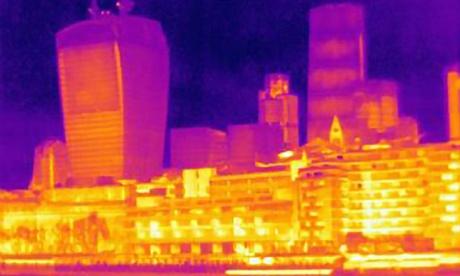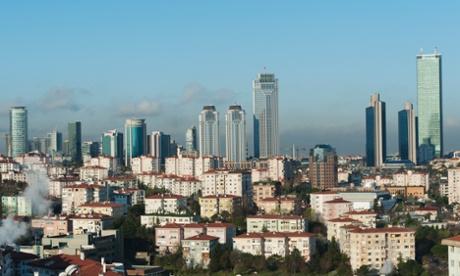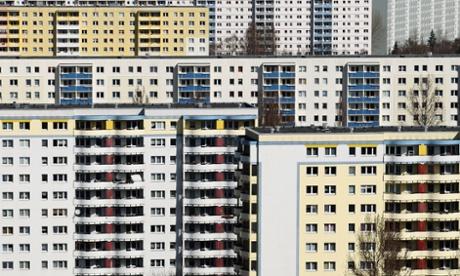As the Intergovernmental Panel on Climate Change (IPCC) finalises its fifth report, cities are again singled out as critical sites for fighting global climate change. Estimates have linked activities in urban areas to as much as 75% of global energy-related carbon emissions.

A thermal image of the London city skyline. Photograph: Joseph Giacomin/Getty Images/Cultura RF
However, cities can also play a key role in any more prosperous, low-carbon future by taking advantage of their enormous potential for energy efficiency. Heat energy demand in residential buildings presents one such opportunity.
The building sector is the biggest source of urban carbon emissions; globally, it accounts for approximately 33% of all energy-related greenhouse gas emissions. And of all the energy used in buildings, heating is the biggest factor: in Europe, approximately 70% of energy use in residential buildings is heating related. Yet typically there can be an enormous – as big as 20-fold – gap in the heat-energy demand of different contemporary buildings. Why is that?
In principle, there are three main factors that have an impact on heat-energy demand: behaviour, technology and design. New research by LSE Cities at the London School of Economics and the European Institute for Energy Research looked specifically at the role building design can play.
Our research inquired about the impact of the basic configurations of residential buildings (“urban morphology”) on energy demand. This impact is a result of two principal determinants of the thermal performance of buildings: the level of exposure to sunlight, which allows buildings to absorb passive solar heat; and the relative amount of external walls, which lead to heat losses.
The combined effect of sunlight exposure and heat loss is best detected at the neighbourhood level, to fully capture how adjacent buildings impact on each other. Therefore, the study was based on a sample of 100 local areas representing the dominant residential building types in Paris, London, Berlin and Istanbul. For each, a computer simulation based on 3D digital building models calculated the average annual heat energy demand per floor area, and also considered yearly variations in outside temperature, the angle of the sun, and different scenarios for local climate and building insulation.

Residential buildings near the centre of Istanbul. Residential buildings near the centre of Istanbul were among those tested. Photograph: Keith Levit/Design Pics/Corbis
Overall, our study found that the impact of building types was much stronger than anticipated. Design related factors led to a difference in heat-energy demand of up to a factor of six.
Compact and taller building types, characteristic of inner-city areas, were found to have the greatest heat-energy efficiency. The compact urban block areas of inner Paris displayed the greatest efficiencies, primarily as a result of minimising heat loss. But taller building types, including several London cases of 20-storey council estates, showed greater heat-energy efficiencies thanks to their exposure to sunlight. Detached housing, typical of suburban developments in all four cities, was found to have the lowest heat-energy efficiencies.
So what are the policy implications of these findings, assuming a high-level of agreement with the underlying evidence? While it is important to consider trade-offs and co-benefits with other policy objectives, the good news is that a greater recognition of the role of urban form and design is something most people can agree on.
The enormous lock-in effects and path dependencies created by the shape of cities is also better understood now, meaning policy needs to be involved at an early stage of city making. Even the broad direction of where we want to take the designs of our cities has become clearer – for instance, the importance of building cities at higher densities as a means of achieving key policy goals such as social inclusion, economic prosperity and environmental sustainability.

Communist-era highrise apartments in the Marzahn district of Berlin, Germany. Communist-era highrise apartments in the Marzahn district of Berlin, Germany. Photograph: Andreas Rentz/Getty Images
But what about the types of homes we want to live in? Clearly, existing suburban housing stocks are substantial, with more than 50% of dwellings in the UK being detached or semi-detached houses. However, housing preferences are beginning to change, and city dwellers are increasingly demanding urban and compact forms of living.
If governments want to support this shift of housing construction towards more compact, and thus more energy efficient, buildings, what action can be taken? Energy price adjustments and climate-related fiscal measures will be critical, but are probably not what cities should rely on. Instead, experience across most cities in the developed world suggests good planning and regulation remains the most powerful tool to assist the better design of cities. And this, in turn, is arguably the most fundamental and long-term factor in the quest for greater global energy efficiency.
Source: Theguardian